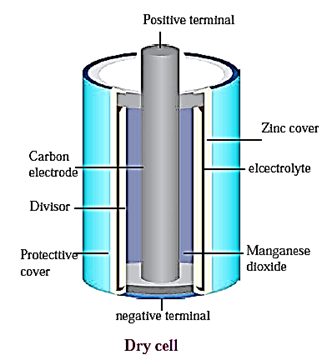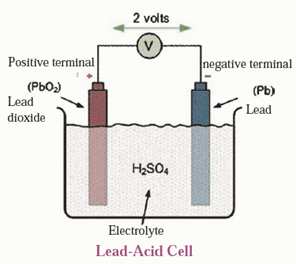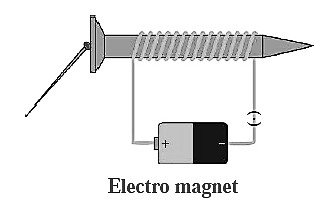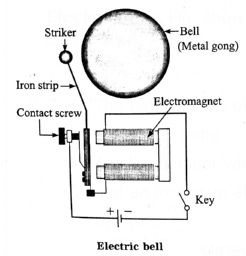Current Electricity and Magnetism
Based on Maharashtra Board Class 8- General Science - Chapter 4-Notes-Solutions-Videos-Tests-PDF
Notes
Topics to be learn :
- Current electricity
- Dry cell, Lead-acid cell, Ni-Cd cell
- Electric circuit
- Magnetic effect of electric current
- Electromagnet
- Electric bell.
Electric current (I) : It is the electric charge (Q) flowing through a conductor, such as a metal wire, per unit time (t).
- Its SI unit is the ampere (A). I = Q/t.
- 1A = 1 coulomb per second.
- Electric current is a scalar quantity.
Electrostatic (electric) potential : The electric level deciding the direction of flow of electric charge is called electrostatic (electric) potential.
- Its SI unit is the volt (V).
- Electrostatic potential is a scalar quantity.
Potential difference : It is the difference between the potentials at two points.
Sources of electricity : Dry cell, lead-acid cell, Ni-Cd cell are sources of electricity.
Electric cell : An electric cell is a general device used to produce a uniform flow of charges in a circuit. Its main function is to maintain a constant potential difference between its two terminals.
Devices in which electric cells are used :
Electric cells are used in radio sets, wall clocks, wrist watches, torches, toys, mobile phones, cars, invertors, remote controls, ships, submarines, satellites, etc.
Dry Cell : Inside protective cover of dry cell there is a whitish, metal layer. This is the zinc (Zn) metal layer. This is the negative terminal of the cell. There is another layer inside. An electrolyte is filled between these two layers. The electrolyte contains negatively charged and positively charged ions. These are the carriers of electricity. The electrolyte is a wet pulp of zinc chloride (ZnCl2) and ammonium chloride (NH4Cl). There is a graphite rod at the centre of the cell. This is positive terminal of the cell. A paste of manganese dioxide (MnO2) is filled outside the rod. Because of the chemical reactions of all these chemicals, electrical charge is produced on the two terminals (graphite rod and Zinc layer) and an electric current flows in the circuit.

Battery : A group of two or more cells connected in series to obtain more potential difference is called a battery.
Lead-acid cell : The lead-acid cell contains two electrodes, Pb and PbO2, dipped in dilute H2S04. Chemical reaction between the substances in the cell produces electric charges on the electrodes. PbO2 carries a positive charge and Pb carries a negative charge. The potential difference between the electrodes is nearly 2V. Because of the chemical reaction between the substances in the cell, electrical charge is produced on both the electrodes and electric current flows through the load (e.g. bulb) in the circuit. This kind of electric cells have a capacity to deliver large current. Hence lead-acid cells are used in cars, trucks, motorcycles and uninterrupted power supplies (UPS).

Solar cell : A solar cell is a device that converts solar energy into electrical energy.
Ni-Cd cell : In this cell, nickel oxide is the positive electrode and cadmium is the negative electrode. The Ni-Cd cell is rechargeable. These days, a variety of gadgets use Ni-Cd cells. The cells deliver 1.2 V potential difference.
| Lithium ion cells are used in modern equipment for example, a smart phone, laptop, etc. These cells can be recharged. More electrical energy can be stored in these cells as compared to that in Ni-Cd cells. |
Connecting cells : The purpose of connecting more cells is to obtain more potential difference than that of a single cell. Therefore, it is possible to obtain higher current. In the transistor radio, 2-3 dry cell are seen to be connected in series. In this series connection, the positive terminal of one cell is connected to the negative terminal of second cell and the positive terminal of the second cell is connected to the negative terminal of the third one. Therefore, if each cell has a potential difference of 1V the total potential difference of 3 cells will be 3V.
Electric circuit (or electrical circuit) : A continuous path consisting of conducting wires, a switch or a plug key and other resistances (example, resistance of an electric bulb) between the terminals of a cell (or a battery) along which an electric current flows is called an electric circuit.

To obtain more potential difference, cells are connected in series.
Electromagnet : If a coil is wound around an iron screw (or an iron rod) and a current is passed through the coil with a cell (or a battery), the screw behaves as a magnet as long as there is current in the coil. The system of the coil and the screw is called an electromagnet.

It is an example of magnetic effect of electric current. This means that magnetic field is created when an electric current flows in a wire.
- Hans Christian Oersted made this observation first.
- Briefly we can say that when an electric current passes through a wire, a magnetic field is produced around that wire.
Applications : Electric bell, cranes for moving heavy loads from one place to another, toys that run on electric cells.
Electromagnets are used to produce a strong magnetic field useful in scientific research.
Electric bell : Fig. shows the construction of an electric bell and also the electric circuit. The working of the electric bell is thus based on the magnetic effect of electric current.

Videos
Click on link to open video
Full Chapter :
1- [video_lightbox_youtube video_id="HLvxe-UV_Q8&rel=0" width="640" height="520" start="10" anchor="Part-1"]
2- [video_lightbox_youtube video_id="mkT-ojDThpE&rel=0" width="640" height="520" start="10" anchor="Part-2"]
3- [video_lightbox_youtube video_id="CtBl8pwa1kg&rel=0" width="640" height="520" start="10" anchor="Part-3"]
4- [video_lightbox_youtube video_id="u4Do5snReCk&rel=0" width="640" height="520" start="10" anchor="Part-4"]
5- [video_lightbox_youtube video_id="NUXb41sBMyI&rel=0" width="640" height="520" start="10" anchor="Part-5"]
Full Chapter : English-Marathi
1- [video_lightbox_youtube video_id="EYxoU3__6-Q&rel=0" width="640" height="520" start="10" anchor="Part-1"]
2- [video_lightbox_youtube video_id="afExQ4sbf3U&rel=0" width="640" height="520" start="10" anchor="Part-2"]
3- [video_lightbox_youtube video_id="A3zPaUzeyJI&rel=0" width="640" height="520" start="10" anchor="Part-3"]
4- [video_lightbox_youtube video_id="mnA7hNaZNyk&rel=0" width="640" height="520" start="10" anchor="Part-4"]
Useful links :
| Main Page : - Maharashtra Board Class 8th General Science - All chapters notes, solutions, videos, test, pdf.
Books : MSBSHSE -Class 8th Science Text Books – Chapter wise PDF for download Previous Chapter : Chapter 3: Force and Pressure - view online Notes Next Chapter : Chapter 5- Inside the Atom - view online Notes |
Nice